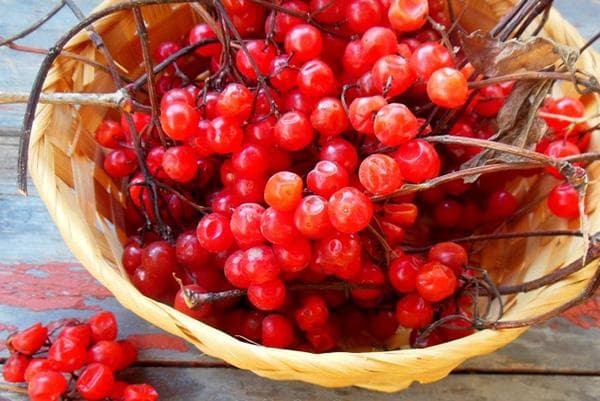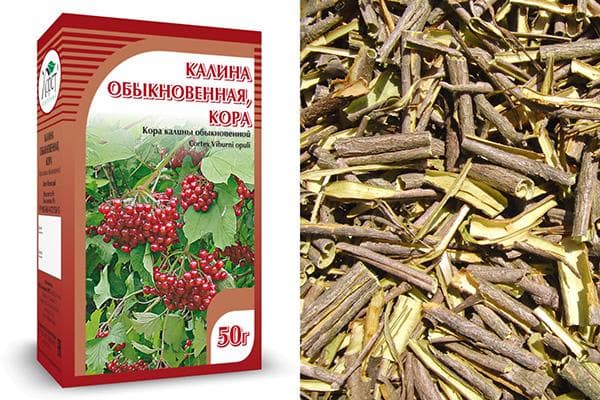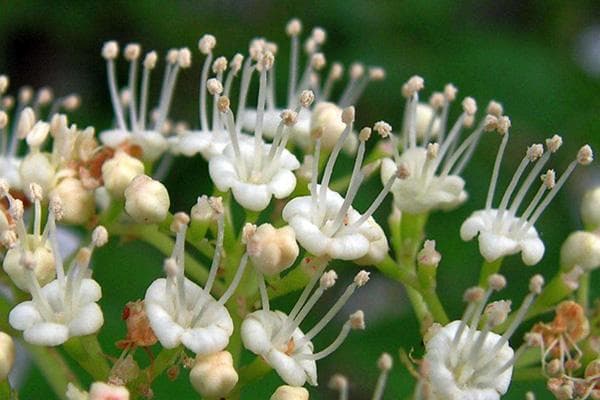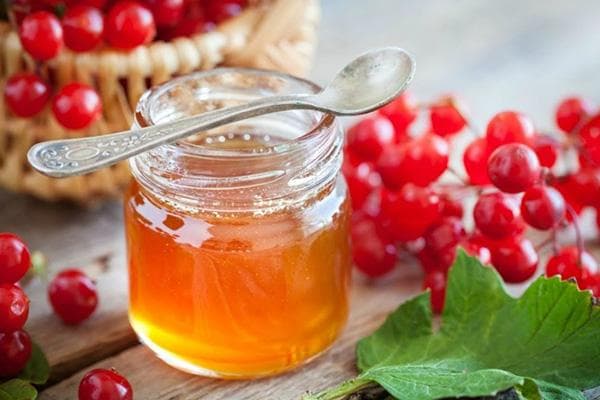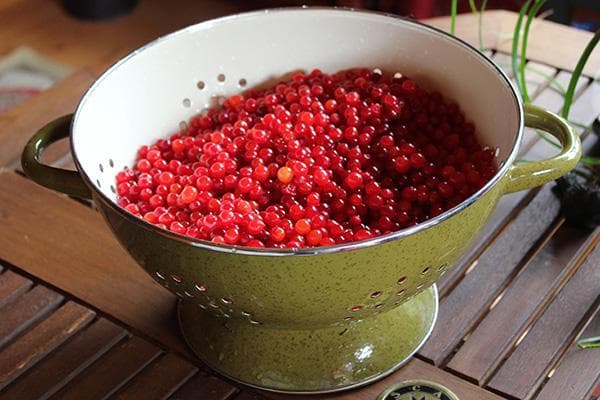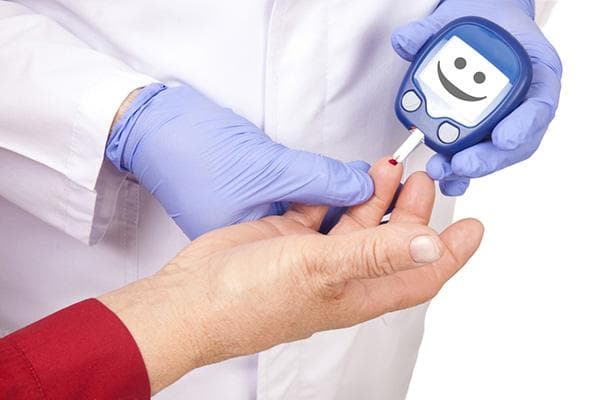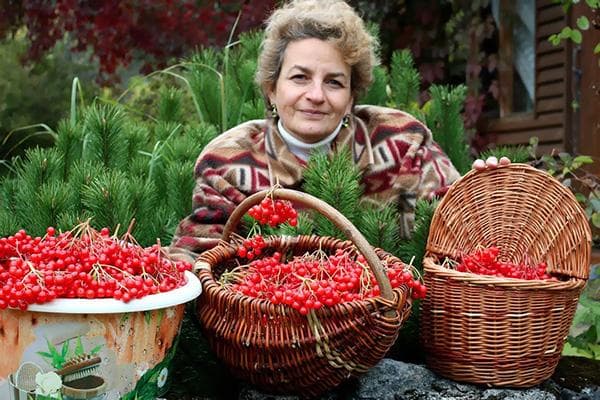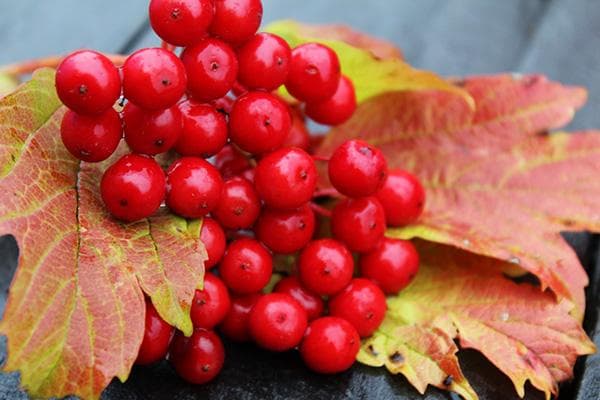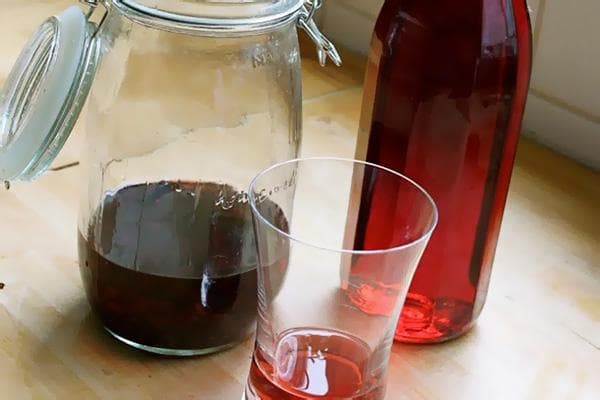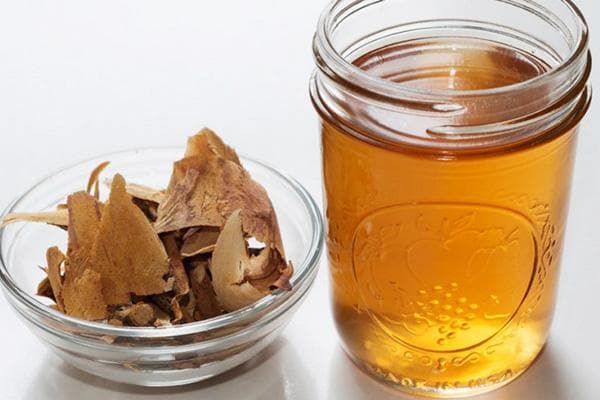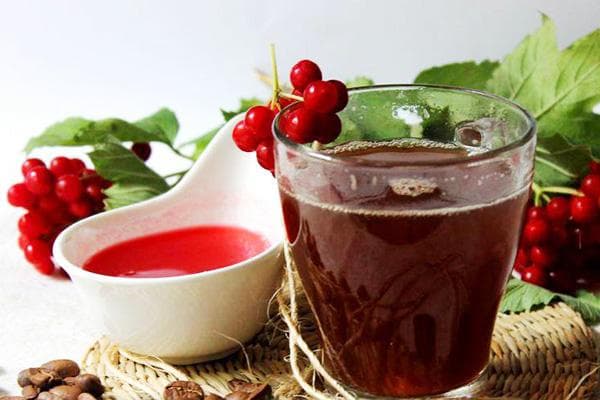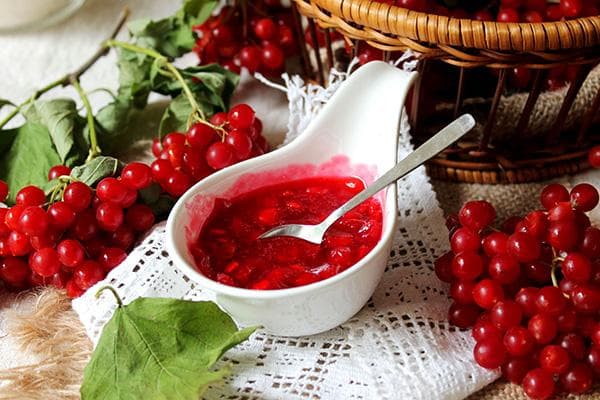Boost your immune system: healthy potions and desserts made from viburnum
Content:
Viburnum, the benefits and harms of which are well studied by modern science, has long been used to treat diseases. Red berries are usually picked in late autumn, when the concentration of vitamins reaches its highest point. After frost, the fruits lose their characteristic bitterness. Other parts of the plant are also used for medicinal purposes: leaves, flowers, bark. We invite you to learn about the beneficial properties and contraindications of viburnum, and familiarize yourself with medication recipes.
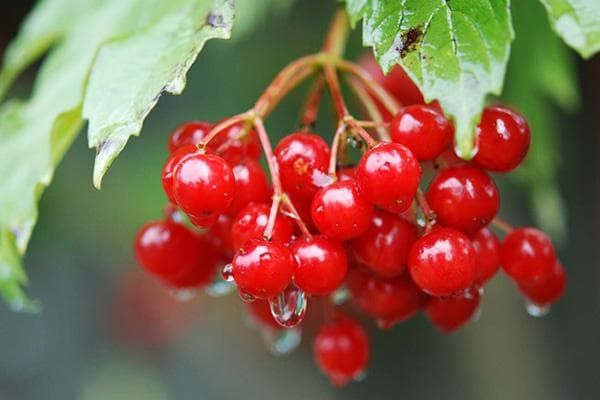
Chemical composition of viburnum
In official and folk medicine, the raw material of Viburnum viburnum – Viburnum opulus – is used. The berries of this tree are red, have a sour-bitter taste and smell like valerian.
But black fruits (for example, from the ornamental shrub Viburnum lantana) cannot be eaten, since they contain substances that are poisonous to humans.Let's consider what chemical composition different parts of the viburnum have.
Berries
The red berries of viburnum are rich in vitamins, macro- and microelements, and organic acids. Sometimes it is enough to eat 100 g of fresh fruits per day to meet the body’s daily need for nutrients.
Table 1. Chemical composition of viburnum berries
| Substance name | % of the daily value in 100 g of berries | Beneficial features |
|---|---|---|
| Vitamin C | 166,7% | Helps the body fight viruses and bacteria, improves blood circulation and vascular tone |
| Vitamin K | 97,9% | Increases blood clotting, helps the body properly absorb calcium |
| Vitamin A, beta-carotene | 16.8% and 18% respectively | Accelerate tissue regeneration, support healthy eyes, skin and reproductive function |
| Vitamin E | 13,3% | Reduces the risk of cancer, slows down the aging process |
| Silicon, calcium | 166.7% and 17.1% respectively | Increases the strength of bones, cartilage, tooth enamel, nails |
| Magnesium | 14,3% | Prevents heart and nervous system diseases |
| Iron | 33,1% | Increases hemoglobin levels in the blood |
| Iodine | 59,8% | Participates in the production of thyroid hormones |
| Selenium | 19,1% | Strengthens immunity |
| Chromium | 120% | Maintains stable blood sugar levels |
Scientists have discovered a high content of valeric acid in viburnum berries. It has a mild laxative effect and helps relieve constipation. But in excess quantities, valeric acid causes a gag reflex.
The bitter taste of viburnum is given by the glycoside viburnin. This substance has a strong antibacterial effect, constricts blood vessels and increases the tone of the uterine muscles.
Bark
Viburnum bark is officially sold in pharmacies as a hemostatic agent.Let's consider what valuable compounds are present in its composition.
- Tannins
When tannins enter the gastrointestinal tract, they create a protective film. They eliminate internal inflammatory processes and help a person get rid of diarrhea.
- Triterpene saponins
They have a detrimental effect on pathogenic fungi in the intestines. Scientists have also proven the ability of triterpene saponins to reduce the level of “bad” cholesterol in the blood.
- Organic acids
Viburnum bark contains the following organic acids: formic, caprylic, acetic, ursolic. They have pronounced antimicrobial and anti-inflammatory properties. An additional benefit of ursolic acid for human health is its ability to prevent the development of cancer cells.
- Other connections
The predominant vitamins in viburnum bark are ascorbic acid, beta-carotene, and phylloquinone. The raw material also contains a lot of phytosterols - substances that lower cholesterol levels and have a diuretic effect.
Leaves and flowers
Viburnum leaves and flowers are rich in vitamin C, tannins and flavonoids. The latter protect the skin from UV radiation, reduce the permeability and fragility of capillaries, and have a detrimental effect on pathogenic bacteria and fungi.
TOP 7 medicinal properties of viburnum
If you prefer healthy eating and folk remedies to tablets from the pharmacy, be sure to store viburnum raw materials at home. This plant will help you prevent many diseases and speed up recovery from existing ailments.
1. Fight viruses and germs
In the cold season, viburnum will protect your body from ARVI. Eat fresh fruits ground with honey, drink berry juice diluted with water or viburnum tea.
The following remedies will also help with respiratory diseases:
- pharyngitis;
- laryngitis;
- tonsillitis;
- tracheobronchitis;
- bronchial asthma.
Viburnum will eliminate pain and redness in the throat, make a dry cough expectorant. If you use it at the onset of the disease, you can prevent the development of complications. Externally, a decoction of the bark and an infusion of flowers are used to treat conjunctivitis, inflammatory processes in the oral cavity (stomatitis, gingivitis), and washing wounds.
2. Treatment of intestinal and gastric diseases
Viburnum helps well with gastrointestinal diseases caused by the action of pathogenic bacteria. In particular, for dysentery, typhoid fever, salmonellosis. It has a detrimental effect on microbes, accelerates the removal of toxins from the body, and restores physical strength.
To get rid of constipation, you need to eat fresh berries, and for diarrhea, drink an infusion of the bark. For stomach dyspepsia, a decoction of viburnum seeds is used.
3. Prevention of type 2 diabetes, obesity
Viburnum berries are a source of bioavailable chromium. This trace element affects the production of the hormone insulin, which is responsible for the absorption of glucose by the body. With regular consumption of fresh fruits, blood sugar levels remain stable. A person’s sudden attacks of hunger and craving for sweets disappear.
Due to the high content of vitamins and organic acids, viburnum accelerates metabolism. The calories received from food are converted into energy, rather than going towards the formation of fat deposits. The calorie content of 100 g of red berries is only 25 kcal, so they definitely won’t harm your figure.
4. Increased performance
Anemia (anemia) is a common problem associated with a decrease in hemoglobin levels in the body.This condition is accompanied by a constant feeling of fatigue, apathy, headaches, muscle weakness, and hair loss.
Viburnum helps prevent anemia because it contains 1/3 of the daily requirement of iron. It is especially useful for women to eat red berries during menstruation.
5. Getting rid of skin problems
Externally, berry juice from viburnum, decoctions of flowers and leaves are used for boils, ulcers, eczema, and allergic rashes. Apply compresses to problem areas of the skin and leave for 1 hour.
Lotions, creams and masks with the addition of viburnum components have an antiseptic and drying effect. Such cosmetics help to tighten pores, eliminate oily shine, acne, and pimples. And juice from fresh berries has a whitening effect.
6. Prevention of cardiovascular diseases
With long-term use of a decoction of viburnum bark, doctors note a decrease in blood cholesterol levels in patients. That is, the risk of a dangerous chronic disease - atherosclerosis - is reduced. Fresh viburnum fruits and tea based on them gently lower blood pressure and normalize heart rate.
7. Improving women's well-being during menstruation
Thanks to the high concentration of vitamin K and tannins, viburnum is able to stop internal bleeding. It reduces the amount of discharge and eliminates pain in the lower abdomen during menstruation. Viburnum berries compensate for the loss of a number of important substances by the female body: iron, selenium, zinc, chromium.
Harm to health of viburnum
The rich chemical composition determines not only the beneficial properties, but also contraindications of viburnum.
You will have to stop eating red berries in the following cases:
- allergy;
- increased acidity of gastric juice, gastritis, stomach ulcer;
- increased blood clotting, the presence of blood clots;
- arthritis, gout and other inflammatory joint diseases;
- pregnancy;
- lactation.
Viburnum can harm hypotensive patients. With regular consumption of berries in large quantities, a person's blood pressure decreases. Abuse of fruits also risks an overdose of vitamin K, which leads to blood thickening.
How to take viburnum correctly - the best folk remedies
If you want to get a therapeutic (preventive) effect, you must know how to take viburnum. We invite you to familiarize yourself with time-tested folk recipes.
Berry tincture with vodka
Viburnum tincture with vodka is used for intestinal infections, respiratory diseases, neuralgia (including insomnia), muscle cramps, as a diuretic and choleretic agent.
To prepare the medicine you will need the following ingredients:
- fresh berries – 0.5 kg;
- vodka – 500 ml.
Sort through the fruits and discard the rotten ones. Rinse under running water and dry. Pour into a darkened glass container. Pour in vodka so that it barely covers the berries. Leave it for a day.
Then add the remaining vodka to the viburnum fruits. Seal the container and leave to infuse in a cool, dark place. After 30 days, strain the tincture and store in the refrigerator. Drink 30–40 drops half an hour before meals 2–3 times a day.
Bark decoction
Viburnum bark is collected and dried in the spring. But it’s easier to buy ready-made raw materials at the pharmacy.
To prepare the decoction you will need 4–5 g of dry bark. Pour a glass of water into a saucepan and bring to a boil. Add the bark and cook for half an hour.Turn off the heat and let the product sit for another 10 minutes.
Strain the broth. Dilute with warm boiled water to the original volume. Drink in small portions (about 20 g) throughout the day.
Viburnum tea
Viburnum tea can be prepared from berries, flowers and leaves. But each option has its own indications for use.
Table 2. Recipes for viburnum tea
| Raw materials | When is tea used? | Recipe |
|---|---|---|
| Fresh berries | For the treatment of diseases of the upper respiratory tract, dry cough, fever, hypovitaminosis, constipation | Mash 1 tbsp. spoon of fruit, pour a glass of boiling water, leave for 10 minutes. Drink with honey. |
| Dry berries | As a diuretic and choleretic agent, to lower blood pressure, for insomnia | 2 tbsp. spoons of berries pour a glass of boiling water, leave for 45 minutes |
| Leaves | As a sedative, for treating intestinal infections, getting rid of worms, and for stomach cramps | Pour 50 g of fresh crushed leaves with a glass of boiling water, leave for half an hour |
| Flowers | As an expectorant for colds, to reduce body temperature, improve digestion and relieve diarrhea | Pour 15–20 g of dried flowers with a glass of boiling water, leave for 20 minutes |
How to make viburnum jam?
Viburnum jam has a rich sweet and sour taste and viscous consistency. This is not just a pleasant treat, but an accessible source of vitamins, macro- and microelements.
To make classic jam you will need the following products:
- fresh viburnum berries – 1 kg;
- sugar – 700–800 g;
- water - glass.
Sort the fruits, rinse under running water, and drain in a colander. Boil water in a deep saucepan. Place viburnum berries in the liquid for 5 minutes.
Boil sugar syrup in a separate container. Combine it with the fruits and boil for 30 minutes. Turn off the heat and let the mixture sit for 6 hours.
Then repeat the procedure: cook the berries until a thick consistency is obtained. Pour viburnum jam into sterilized jars and seal.
Thus, viburnum has a wide range of beneficial properties. But most of all, the plant is valued for its ability to effectively cope with viruses, bacteria, fungi, eliminate inflammation and internal bleeding in the body. Keep berries, bark or other parts of viburnum in your home medicine cabinet to avoid getting sick.
